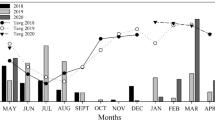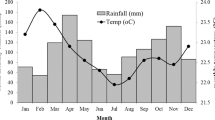Abstract
Silvopasture is an alternative to open pasture (OP), but the effect of trees on understory grass canopy structure and tiller morphology is not well defined. Our objective was to compare herbage accumulation, canopy structure, and tiller morphology of Brachiaria brizantha (Hochst. ex A. Rich.) Stapf. cv. Marandu (palisadegrass) growing in OP or in silvopasture with Eucalyptus urograndis (hybrid of E. grandis W. Hill ex Maiden and E. urophylla S. T. Blake), in the Amazon biome. From October 2015 to September 2016, all experimental units were stocked continuously with beef cattle using a variable stocking rate to maintain a palisadegrass canopy height of 30 cm. The trees were planted in triple-row groves (3.0 m between trees, 3.5 m between rows), with 30 m between groves, totaling 270 trees ha−1. The herbage accumulation (HA) was similar among systems (averaging 12.1 Mg ha−1 year−1). The silvopasture decreased herbage mass (HM) 24% and herbage bulk density (HBD) by 20% compared with OP. Tiller leaf area was 18% greater in the silvopasture. Total number of leaves (4.95 ± 0.26), and live leaves tiller−1 (3.25 ± 0.14) were not affected by system or system × season interaction. In a silvopasture, palisadegrass maintained leaf area index, number of total, live and dead leaves, tiller weight, internode length and stem length similar to the OP. Under moderate shade, especially at 4-m distance from the edge row of trees, palisadegrass enhanced the area of each leaf while the number of live leaves tiller−1 and tiller density decreased in order to maintain productivity. Silvopasture has potential as an alternative system for livestock production in the Brazilian Amazon Biome.




Similar content being viewed by others
References
ABIEC (2019) Perfil da pecuária no Brasil. In: Beef Rep. http://www.abiec.com.br/controle/uploads/arquivos/sumario2019portugues.pdf. Accessed 20 Aug 2019
Alvares CA, Stape JL, Sentelhas PC et al (2013) Köppen’s climate classification map for Brazil. Meteorol Z 22:711–728. https://doi.org/10.1127/0941-2948/2013/0507
Assuero SG, Tognetti J (2010) Tillering regulation by endogenous and environmental factors and its agricultural management. Am J Plant Sci Biotechnol 4:35–48
Carvalho P, Domiciano LF, Mombach MA et al (2019) Forage and animal production on palisadegrass pastures growing in monoculture or as a component of integrated crop–livestock–forestry systems. Grass Forage Sci 74:650–660. doi:https://doi.org/10.1111/gfs.12448
Dick M, Da Silva MA, Dewes H (2015) Mitigation of environmental impacts of beef cattle production in southern Brazil - evaluation using farm-based life cycle assessment. J Clean Prod 87:58–67. https://doi.org/10.1016/j.jclepro.2014.10.087
Domiciano LF, Mombach MA, Carvalho P et al (2018) Performance and behaviour of Nellore steers on integrated systems. Anim Prod Sci 58:920. doi:https://doi.org/10.1071/AN16351
Domiciano LF, Pedreira BC, da Silva NMF et al (2020) Agroforestry systems: an alternative to intensify forage-based livestock in the Brazilian Amazon. Agrofor Syst 94:1839–1849. doi:https://doi.org/10.1007/s10457-020-00499-1
Euclides VPB, Macedo MCM, Valle CB et al (2008) Produção de forragem e características da estrutura do dossel de cultivares de Brachiaria brizantha sob pastejo. Pesqui Agropecuária Bras 43:1805–1812. doi:https://doi.org/10.4025/actascianimsci.v32i2.8498
Euclides VPB, Montagner DB, Macedo MCM et al (2019) Grazing intensity affects forage accumulation and persistence of Marandu palisadegrass in the Brazilian savannah. Grass Forage Sci 1:1–13. doi:https://doi.org/10.1111/gfs.12422
Feldhake CM, Belesky DP (2009) Photosynthetically active radiation use efficiency of Dactylis glomerata and Schedonorus phoenix along a hardwood tree-induced light gradient. Agrofor Syst 75:189–196. doi:https://doi.org/10.1007/s10457-008-9175-9
Fornara DA, Olave R, Burgess P et al (2018) Land use change and soil carbon pools: evidence from a long-term silvopastoral experiment. Agrofor Syst 92:1035–1046. doi:https://doi.org/10.1007/s10457-017-0124-3
Gastal F, Lemaire G (2015) Defoliation, shoot plasticity, sward structure and herbage utilization in pasture: review of the underlying ecophysiological processes. Agriculture 5:1146–1171. https://doi.org/10.3390/agriculture5041146
Geremia EV, Crestani S, Mascheroni JDC et al (2018) Sward structure and herbage intake of Brachiaria brizantha cv. Piatã in a crop-livestock-forestry integration area. Livest Sci 212:83–92. doi:https://doi.org/10.1016/j.livsci.2018.03.020
Gobbi KF, Garcia R, Ventrella MC et al (2011) Área foliar específica e anatomia foliar quantitativa do capim-braquíria e do amendoim-forrageiro submetidos a sombreamento. Rev Bras Zootec 40:1436–1444. doi:https://doi.org/10.1590/S1516-35982011000700006
Gomes FJ, Pedreira BC, Santos PM et al (2020a) Microclimate effects on canopy characteristics of shaded palisadegrass pastures in a silvopastoral system in the Amazon biome of central Brazil. Eur J Agron 115:126029. doi:https://doi.org/10.1016/j.eja.2020.126029
Gomes FJ, Pedreira BC, Santos PM et al (2020b) Shading effects on canopy and tillering characteristics of continuously stocked palisadegrass in a silvopastoral system in the Amazon biome. Grass Forage Sci 75:279–290. doi:https://doi.org/10.1111/gfs.12478
Gomes FJ, Pedreira CGS, Bosi C et al (2019) Shading effects on marandu palisadegrass in a silvopastoral system: plant morphological and physiological responses. Agron J 111:2332–2340. doi:https://doi.org/10.2134/agronj2019.01.0052
Gómez S, Guenni O, Bravo de Guenni L (2013) Growth, leaf photosynthesis and canopy light use efficiency under differing irradiance and soil N supplies in the forage grass Brachiaria decumbens Stapf. Grass Forage Sci 68:395–407. https://doi.org/10.1111/gfs.12002
Jose S, Dollinger J (2019) Silvopasture: a sustainable livestock production system. Agrofor Syst 93:1–9. doi:https://doi.org/10.1007/s10457-019-00366-8
Klingman DL, Miles SR, Mott GO (1943) The cage method for determining consumption and yield of pasture herbage. J Am Soc Agron 35:739–746
Klute A (1986) Water retention: laboratory methods. In: Methods soil Anal part 1—physical Mineral methods, pp 635–662
Lemaire G, Da Silva SC, Agnusdei M et al (2009) Interactions between leaf lifespan and defoliation frequency in temperate and tropical pastures: a review. Grass Forage Sci 64:341–353. doi:https://doi.org/10.1111/j.1365-2494.2009.00707.x
Lima MA, Paciullo DSC, Morenz MJF et al (2019a) Productivity and nutritive value of Brachiaria decumbens and performance of dairy heifers in a long-term silvopastoral system. Grass Forage Sci 74:160–170. doi:https://doi.org/10.1111/gfs.12395
Lima MA, Paciullo DSC, Silva FF et al (2019b) Evaluation of a long-established silvopastoral Brachiaria decumbens system: plant characteristics and feeding value for cattle. Crop Pasture Sci 70:814. doi:https://doi.org/10.1071/CP19027
Littell RC, Milliken GA, Stroup WW et al (2006) SAS for mixed models. SAS Institute
Matthew C, Assuero SG, Black CK, Hamilton NRS (2016) Tiller dynamics of grazed swards. Grassland ecophysiology and grazing ecology. CABI, Wallingford, pp 127–150
Matthew C, Mackay A, Robin A (2016b) Do phytomer turnover models of plant morphology describe perennial ryegrass root data from field swards? Agriculture 6:28. doi:https://doi.org/10.3390/agriculture6030028
Mezzalira JC, De Faccio Carvalho PC, Fonseca L et al (2014) Behavioural mechanisms of intake rate by heifers grazing swards of contrasting structures. Appl Anim Behav Sci 153:1–9. doi:https://doi.org/10.1016/j.applanim.2013.12.014
Nascimento HLB, Pedreira BC, Sollenberger LE et al (2019) Physiological characteristics and forage accumulation of grazed Marandu palisade grass (Brachiaria brizantha) growing in monoculture and in silvopasture with Eucalyptus urograndis. Crop Pasture Sci 70:384–394. https://doi.org/10.1071/CP18403
Paciullo DSC, Carvalho CAB de, Aroeira LJM et al (2007) Morfofisiologia e valor nutritivo do capim-braquiária sob sombreamento natural e a sol pleno. Pesqui Agropecu Bras 42:573–579
Paraiso IGN, Silva DSM, Carvalho APS et al (2019) Herbage accumulation, nutritive value, and organic reserves of continuously stocked ‘Ipyporã’ and ‘Mulato II’ brachiariagrasses. Crop Sci 59:2903–2914. doi:https://doi.org/10.2135/cropsci2019.06.0399
Pedreira CGS, Silva VJ, Pedreira BC, Sollenberger LE (2017) Herbage accumulation and organic reserves of palisadegrass in response to grazing management based on canopy targets. Crop Sci 57:2283–2293. doi:https://doi.org/10.2135/cropsci2016.11.0957
Pezzopane JRM, Bosi C, Nicodemo MLF et al (2015) Microclimate and soil moisture in a silvopastoral system in southeastern Brazil. Bragantia 74:110–119. doi:https://doi.org/10.1590/1678-4499.0334
Santos D, de C, Guimarães Júnior R, Vilela L et al (2016) Forage dry mass accumulation and structural characteristics of Piatã grass in silvopastoral systems in the Brazilian savannah. Agric Ecosyst Environ 233:16–24. doi:https://doi.org/10.1016/j.agee.2016.08.026
Sbrissia AF, da Silva SC (2008) Tiller size/density compensation in Marandu palisadegrass swards (Portuguese). Rev Bras Zootec 37:35–47. doi:https://doi.org/10.1590/S1516-35982008000100005
Silva FS, Domiciano LF, Gomes FJ et al (2020) Herbage accumulation, nutritive value and beef cattle production on marandu palisadegrass pastures in integrated systems. Agrofor Syst 94:1891–1902. doi:https://doi.org/10.1007/s10457-020-00508-3
Soil Science Division Staff (2017) Soil Survey Manual. US Gov. Print. Office, Washington, D.C.
Sollenberger LE, Kohmann MM, Dubeux JCB, Silveira ML (2019) Grassland management affects delivery of regulating and supporting ecosystem services. Crop Sci 59:1–19. doi:https://doi.org/10.2135/cropsci2018.09.0594
Taiz L, Zieger E (2009) Plant Physiology. Artmed, Porto Alegre
Thornthwaite CW, Mather JR (1955) The water balance. Publications in climatology, 8th edn. Laboratory of Climatology, Centerton, p 104
Torres CMME, Jacovine LAG, De Olivera Neto N S, et al (2017) Greenhouse gas emissions and carbon sequestration by agroforestry systems in southeastern Brazil. Sci Rep 7:1–7. doi:https://doi.org/10.1038/s41598-017-16821-4
Wolfinger R (1993) Covariance structure selection in general mixed models. Commun Stat Simul Comput 22:1079–1106. https://doi.org/10.1080/03610919308813143
Acknowledgements
The authors acknowledge CNPq (National Counsel of Technological and Scientific Development) for support (479409/2013-7, 303438/2015-0) and granting a scholarship to the first author; and Acrinorte (Association of Northern Mato Grosso’s farmers) for the partnership with the beef cattle used (44.771/14 and 50.168/2017). This work was supported by Embrapa (Grant Numbers 02.13.11.001.00.00); and Acrimat (Association of Mato Grosso’s farmers).
Author information
Authors and Affiliations
Corresponding author
Ethics declarations
Conflict of interest
The authors declare no conflicts of interest.
Additional information
Publisher's Note
Springer Nature remains neutral with regard to jurisdictional claims in published maps and institutional affiliations.
Rights and permissions
About this article
Cite this article
Nascimento, H.L.B., Pedreira, B.C., Sollenberger, L.E. et al. Herbage accumulation, canopy structure and tiller morphology of marandu palisadegrass growing in open pasture and in silvopasture. Agroforest Syst 95, 339–352 (2021). https://doi.org/10.1007/s10457-020-00590-7
Received:
Accepted:
Published:
Issue Date:
DOI: https://doi.org/10.1007/s10457-020-00590-7




